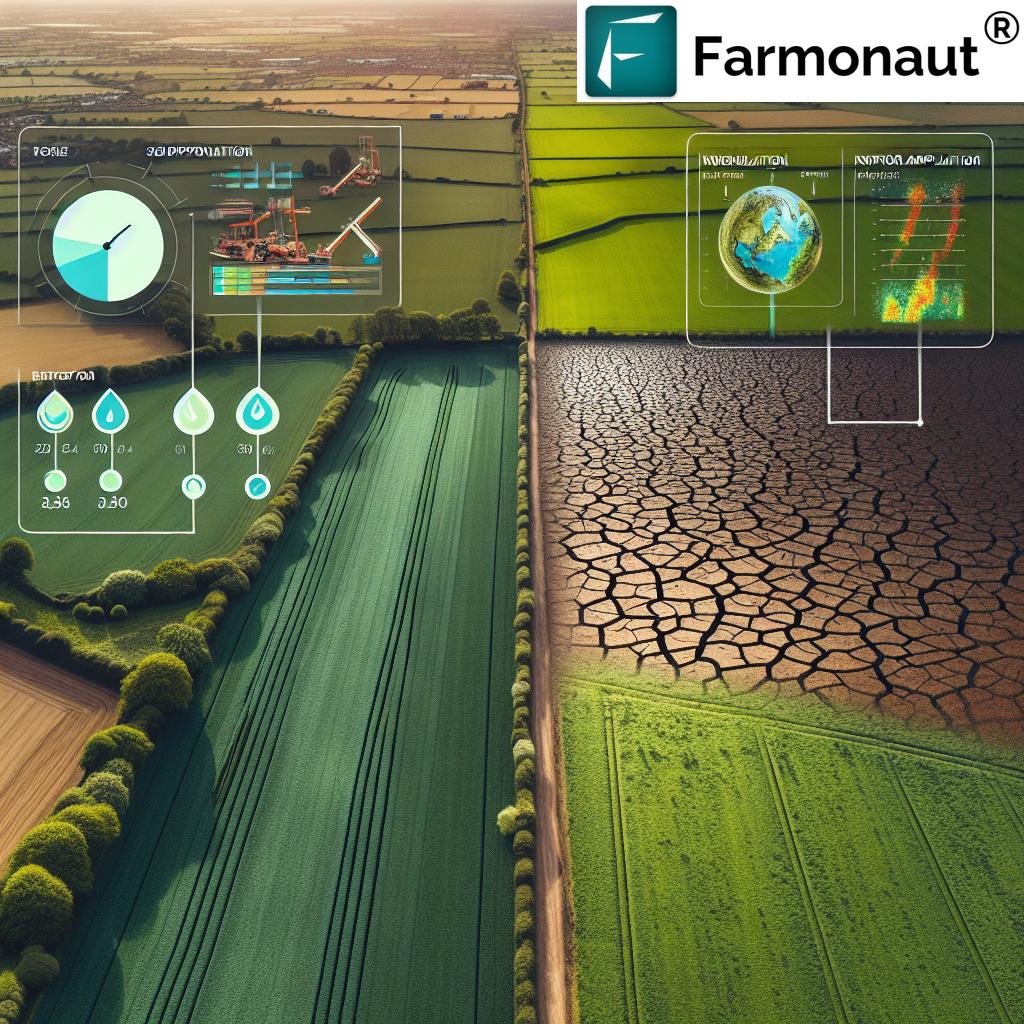Optimizing UK Soil Moisture Management: Sustainable Nitrogen Application Strategies for Drought-Resilient Farming

“Proper soil moisture management can increase nitrogen use efficiency by up to 40% in drought-prone agricultural areas.“
In the face of increasing climate variability, UK farmers are confronted with the challenge of maintaining productive and sustainable agricultural practices. As we navigate through periods of prolonged dry spells and unpredictable rainfall patterns, the need for optimizing soil moisture management and implementing effective nitrogen application strategies has never been more critical. In this comprehensive guide, we’ll explore crucial techniques for drought-resilient farming and sustainable grazing practices, with a particular focus on the UK agricultural sector.
At Farmonaut, we understand the complexities of modern farming and the importance of precision agriculture in addressing these challenges. Our satellite-based farm management solutions provide farmers with the tools they need to make informed decisions about crop health, resource allocation, and sustainable farming practices. Let’s delve into the strategies that can help UK farmers optimize their soil moisture management and nitrogen application for successful grass growth, even in challenging dry conditions.
The Importance of Soil Moisture Management in UK Agriculture
Soil moisture is a critical factor in determining crop growth and nutrient availability. In the UK, where weather patterns can be unpredictable, effective soil moisture management is essential for maintaining consistent crop yields and pasture health. Here are some key points to consider:
- Soil moisture acts as a medium for nutrient transport to plant roots
- Adequate moisture levels are crucial for microbial activity and organic matter decomposition
- Proper moisture management can significantly improve fertilizer efficiency
- Drought stress can severely impact crop yields and quality
To address these challenges, UK farmers need to adopt a proactive approach to soil moisture management. This involves implementing strategies that conserve water, improve soil structure, and enhance the soil’s water-holding capacity.
Sustainable Nitrogen Application Strategies for Drought Conditions
Nitrogen is a vital nutrient for plant growth, but its application must be carefully managed, especially during dry periods. Here’s why avoiding inorganic nitrogen applications during low soil moisture conditions is crucial:
- Reduced nutrient uptake: Plants struggle to absorb nutrients in dry soil
- Increased risk of volatilization: Nitrogen can be lost to the atmosphere as ammonia gas
- Potential for soil damage: Concentrated fertilizers can harm soil microorganisms
- Waste of resources: Ineffective application leads to economic losses
To maximize fertilizer efficiency in agriculture and promote sustainable farming practices, consider the following strategies:
- Timing is everything: Apply nitrogen when soil moisture levels are adequate and plants are actively growing.
- Use slow-release formulations: These products provide a steady supply of nitrogen over time, reducing losses.
- Implement split applications: Divide the total nitrogen dose into multiple smaller applications throughout the growing season.
- Incorporate organic matter: This improves soil structure and water-holding capacity, enhancing nutrient retention.
Precision Agriculture Techniques for Soil Nutrient Management
Precision agriculture is revolutionizing the way farmers manage their crops and resources. By leveraging technology and data-driven insights, UK farmers can optimize their soil nutrient management practices. Here’s how:
- Satellite imagery for crop health monitoring
- Soil mapping and variable rate applications
- Weather data integration for better decision-making
- AI-powered advisory systems for personalized recommendations
At Farmonaut, we offer cutting-edge solutions that enable farmers to harness the power of precision agriculture. Our satellite-based crop health monitoring system provides real-time insights into vegetation health, soil moisture levels, and other critical metrics. This data helps farmers make informed decisions about irrigation, fertilizer usage, and pest management, ultimately optimizing crop yields and reducing resource wastage.
Maintaining Ground Cover: A Key Strategy for Water Conservation
One of the most effective ways to mitigate water loss and improve soil moisture retention is by maintaining adequate ground cover. This is particularly important after silage cutting or intensive grazing periods. Here’s why ground cover matters:
- Reduces soil surface evaporation
- Protects soil structure from rain impact
- Enhances water infiltration
- Supports soil biological activity
To maintain effective ground cover, consider the following practices:
- Rotational grazing: This allows pastures to recover and maintain adequate leaf area.
- Cover cropping: Plant cover crops after harvest to protect and improve soil during fallow periods.
- Residue management: Leave crop residues on the field to protect soil and slow water runoff.
- Diverse species mix: Use a variety of plant species to create a more resilient ground cover.
“Strategic lime application can improve soil pH by 0.5-1 units, enhancing nutrient availability and drought resilience in crops.“
The Strategic Use of Lime and Potash for Soil Resilience
Improving soil resilience is crucial for drought-resistant farming. The strategic use of lime and potash can play a significant role in enhancing soil health and moisture retention. Here’s how:
Lime Application:
- Corrects soil acidity
- Improves nutrient availability
- Enhances soil structure
- Promotes beneficial microbial activity
Potash Application:
- Improves water use efficiency
- Enhances root development
- Increases plant tolerance to drought stress
- Supports overall plant health and vigor
When applying lime and potash, it’s essential to consider soil test results and crop requirements. Farmonaut’s AI-powered advisory system can help farmers determine the optimal application rates and timing for these soil amendments.
Explore Farmonaut’s API for advanced agricultural insights
Adapting Crop Rotation Strategies for Drought Resilience
Crop rotation is a time-tested practice that can significantly improve soil health and drought resilience. By carefully planning crop sequences, UK farmers can enhance soil structure, increase organic matter content, and improve water retention capacity. Here are some strategies to consider:
- Incorporate deep-rooted crops to improve soil structure
- Alternate water-intensive crops with drought-tolerant varieties
- Include legumes in the rotation to improve soil nitrogen content
- Use cover crops during fallow periods to protect and enrich the soil
Implementing an effective crop rotation strategy requires careful planning and consideration of local conditions. Farmonaut’s platform can assist farmers in analyzing historical data and weather patterns to optimize their rotation plans.
Extending Grazing Rotations for Pasture Health
For livestock farmers, extending grazing rotations can be an effective strategy for maintaining pasture health during dry conditions. This approach allows for longer recovery periods between grazing events, promoting deeper root growth and improved drought tolerance. Consider the following techniques:
- Implement mob grazing: High-intensity, short-duration grazing followed by extended rest periods.
- Establish diverse pasture species: Mix drought-tolerant grasses and legumes for resilience.
- Utilize temporary electric fencing: This allows for flexible paddock management and precise grazing control.
- Monitor pasture growth rates: Adjust stocking rates based on available forage to prevent overgrazing.
By adopting these practices, farmers can improve pasture productivity and sustainability, even in challenging dry conditions.

AgTech Solutions for Dry Conditions: Farmonaut’s Innovative Approach
As the agricultural sector faces increasing challenges from climate variability, innovative agtech solutions are becoming essential for sustainable farming. Farmonaut’s suite of tools offers UK farmers advanced capabilities to navigate these challenges:
- Satellite-based crop monitoring: Real-time insights into crop health and soil moisture levels.
- AI-powered advisory system: Personalized recommendations for crop management and resource allocation.
- Weather forecasting integration: Accurate local weather predictions to inform farming decisions.
- Resource management tools: Optimize water and fertilizer use for maximum efficiency.
By leveraging these technologies, farmers can make data-driven decisions that improve their resilience to dry conditions and optimize their agricultural practices.
Comparative Analysis of Nitrogen Application Strategies
| Application Strategy | Soil Moisture Conditions | Estimated Nitrogen Use Efficiency (%) | Potential Yield Impact (%) | Environmental Impact | Cost-Effectiveness |
|---|---|---|---|---|---|
| Traditional inorganic nitrogen application | Varied | 40-60 | 0-10 | High | Medium |
| Precision agriculture-based application | Optimized | 60-80 | 10-20 | Low | High |
| Slow-release nitrogen fertilizers | Varied | 50-70 | 5-15 | Medium | Medium |
| Organic nitrogen sources (e.g., manure, compost) | Varied | 30-50 | 0-10 | Low | High |
| No nitrogen application during drought | Low | N/A | -10 to 0 | Low | Low |
This table provides a clear overview of various nitrogen management approaches, their effectiveness, and environmental impact. It serves as a quick reference guide for UK farmers looking to optimize their fertilizer strategies for drought-resilient farming.
Future Outlook: Sustainable Farming in a Changing Climate
As we look to the future of UK agriculture, it’s clear that adapting to changing climate conditions will be crucial for long-term sustainability. By embracing innovative technologies, implementing sustainable practices, and prioritizing soil health, farmers can build resilient agricultural systems capable of withstanding the challenges of drought and variable weather patterns.
Farmonaut is committed to supporting UK farmers in this transition, providing cutting-edge tools and insights to optimize farm management and resource use. Our platform continues to evolve, incorporating the latest advancements in satellite technology, AI, and data analytics to deliver actionable insights for sustainable and profitable farming.
Conclusion: Embracing Innovation for Drought-Resilient Farming
Optimizing soil moisture management and implementing sustainable nitrogen application strategies are critical steps towards building drought-resilient farming systems in the UK. By leveraging precision agriculture techniques, maintaining ground cover, adapting crop rotations, and utilizing innovative agtech solutions, farmers can significantly improve their ability to withstand dry conditions while maintaining productivity and sustainability.
As we navigate the challenges of climate change and resource conservation, the agricultural sector must continue to evolve and adapt. Farmonaut stands ready to support UK farmers in this journey, offering advanced tools and insights to help optimize farm management practices and build a more resilient, sustainable future for British agriculture.
Access Farmonaut’s API Developer Docs for integration options
FAQ: Optimizing Soil Moisture and Nitrogen Management
Q: How often should I monitor soil moisture levels?
A: We recommend monitoring soil moisture at least weekly, or more frequently during dry periods. Farmonaut’s satellite-based monitoring can provide daily updates on soil moisture conditions.
Q: What are the signs of nitrogen deficiency in crops?
A: Common signs include yellowing of older leaves (chlorosis), stunted growth, and reduced yield. However, these symptoms can be similar to other nutrient deficiencies, so soil testing is recommended for accurate diagnosis.
Q: How can I improve my soil’s water-holding capacity?
A: Increase organic matter content through cover cropping, crop residue management, and applying compost. Additionally, minimizing soil disturbance and maintaining soil structure can significantly improve water retention.
Q: Is it better to apply nitrogen in liquid or granular form during dry conditions?
A: In dry conditions, liquid nitrogen formulations can be more effective as they’re more readily available to plants. However, the best choice depends on your specific soil conditions and application equipment.
Q: How can precision agriculture help me manage nitrogen application more effectively?
A: Precision agriculture tools, like those offered by Farmonaut, can help you map field variability, monitor crop health in real-time, and apply nitrogen at variable rates across your field. This ensures that you’re applying the right amount of nitrogen in the right places, improving efficiency and reducing waste.






